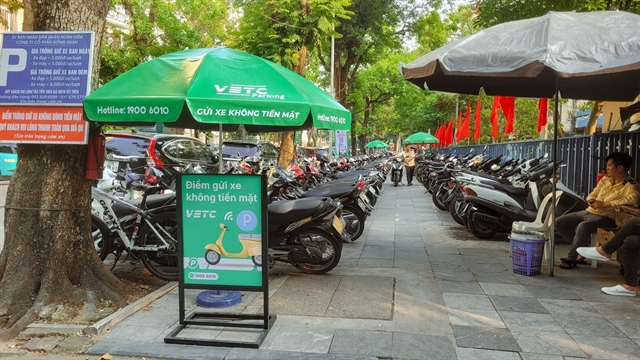 Society
Society

 |
| A parking site in Hà Nội that is piloting cashless payment technology. VNA/VNS Photo Việt Hùng |
HÀ NỘI — Hà Nội’s Department of Construction has called on the city police to step up inspections of parking areas piloting cashless payment technology and to suspend or revoke the licences of sites found in violation of regulations.
According to deputy director of the department Trần Hữu Bảo, after more than a year of piloting the non-cash parking model, the initiative has significantly improved revenue transparency and helped curb overcharging for parking fees and reduce budget leakage.
Currently, Hà Nội has 405 designated parking lots and points using cashless payment solutions. Of these, VETC provides services to 234 sites, while VDTC covers 171 sites.
The department reported that over 94.9 per cent of payments were made via VETC and VDTC systems, with 843,892 transactions, up from 88.6 per cent in the first phase. Meanwhile, cash payments dropped to 5.1 per cent or 45,172 transactions, down from 11.4 per cent.
For motorbikes, 93.1 per cent of payments were made via QR code, totalling 565,954 transactions, up 7.2 percentage points from the initial phase. Cash was used in 6.9 per cent of cases.
For cars, 98.9 per cent of transactions, or 268,938 in total, were made using QR codes, VETC or ePass, marking a 1.2 percentage point increase from the previous period.
Bảo emphasised that cashless payments offer greater convenience to the public.
“Users no longer need to carry small change or worry if they forget their wallet. Transactions are quicker and more aligned with modern urban lifestyles and the growing trend toward cashless consumption,” he said.
He noted that digital payments help make fee collection more transparent and streamline revenue management. The data collected also supports State agencies in analysing parking demand, enabling more scientific and practical planning of parking infrastructure.
Persistent challenges
Despite the progress, Bảo acknowledged that shortcomings remain.
Many cashless parking sites lack proper visual identifiers. Some have registered to use the technology, but show no actual transactions or only token transactions during inspections.
“The effectiveness of the cashless system, especially at open-air lots, still depends largely on the compliance of on-site staff. In some cases, employees only use scanning devices when inspectors are present,” he said.
Technical issues are also common. The payment systems can crash or freeze, and licence plate scanners at curbside car parks often malfunction due to poor internet connection, short battery life, or software errors that require frequent restarts.
Many residents, particularly older adults, remain hesitant to adopt new technologies and are more comfortable using cash. Currently, there is no solution for users without digital payment access, such as students, the elderly or those without mobile internet access.
Moreover, Decision 4696/QĐ-UBND issued by the city’s People’s Committee on September 6, 2024, does not mandate cashless payments, leaving adoption largely voluntary.
As a result, many parking operators continue to collect cash without facing penalties. The lack of enforcement mechanisms for those failing to submit accurate data, along with inconsistent commitment from local authorities, further hampers progress.
High investment and maintenance costs for equipment, particularly at small-scale parking sites, also remain a barrier.
To address these issues, the Department of Construction has proposed that the city introduce policies to support individuals and organisations in adopting cashless parking technologies, especially at smaller sites.
It is also directing the development of a centralised mobile application that helps users locate authorised parking spots, provides real-time information on prices, capacity, and operating hours, and allows reservations during peak times to reduce illegal parking.
Parking service providers have been instructed to raise awareness among staff and ensure compliance with regulations to improve the quality and transparency of parking operations. — VNS




